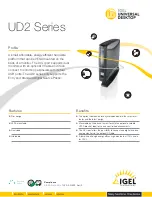
Hardware Reference Guide
B–5
Hard Drive Installation Guidelines
Guidelines for Installing Optional SCSI Devices
✎
If you mix Ultra ATA and SCSI hard drives in the same system, the
Ultra ATA drive will be the boot drive unless the boot order is
changed in the F10 Setup.
When replacing a hard drive, the replacement drive should be of the
same type as the drive being removed. If you are replacing an Ultra
ATA hard drive with a SCSI hard drive, you will need a multimode
Low Voltage Differential (LVD) SCSI cable option kit.
If only one SCSI hard drive is used, it should be installed in bay 4 if
your computer has four or more bays.
Before installing a SCSI device:
■
Verify the SCSI ID of the drive and, if necessary, set the SCSI ID
to a unique number. See “Guidelines for Using SCSI Devices” in
this appendix or refer to the documentation included with the
device.
■
Determine if the device requires that termination be enabled or
disabled. Set the termination if necessary. See “Using a SCSI
Cable” in this appendix or refer to the documentation included
with the device.
✎
Some devices may not have terminating jumpers on the device.
Termination on these devices must be achieved with terminated cable.
Turn on an external SCSI device before turning on power to the
computer. This enables the system board controller to recognize the
external SCSI device and automatically reset. When an external SCSI
device is connected to the external SCSI connector on the rear panel
of the computer, that device becomes the end of the SCSI chain and
must be terminated.
SCSI Controllers
Select models such as workstations ship with an integrated single
channel Ultra 160 SCSI controller with an internal connector on the
system board.















































